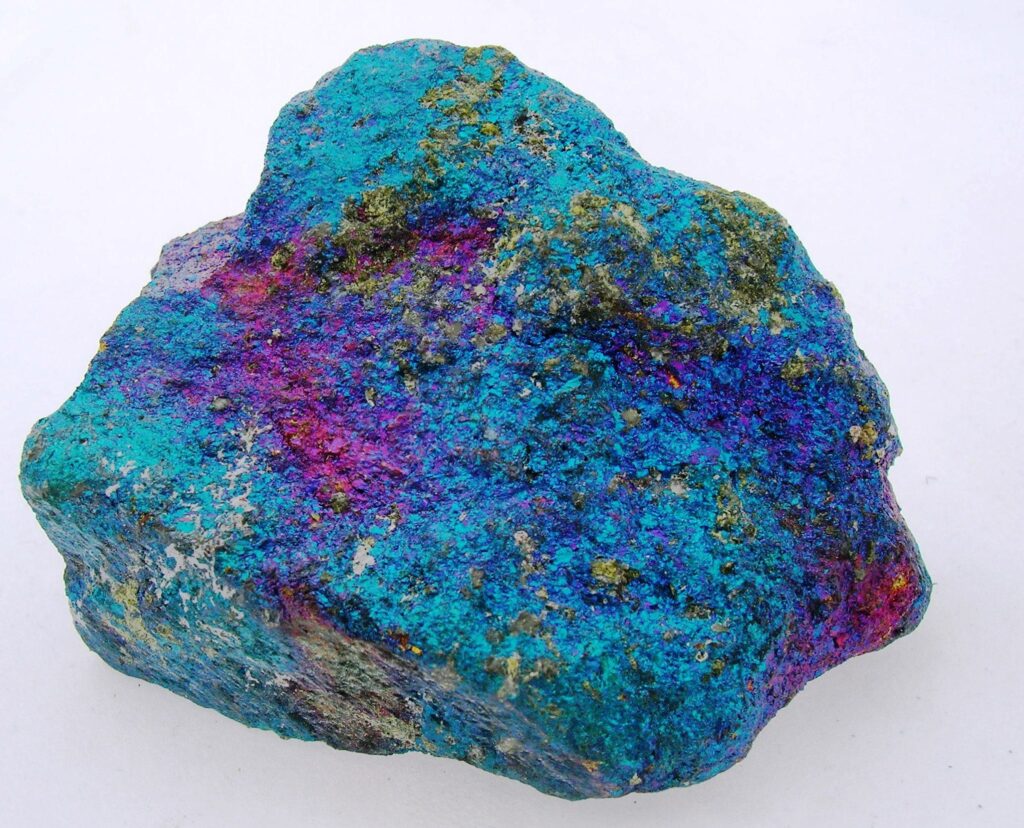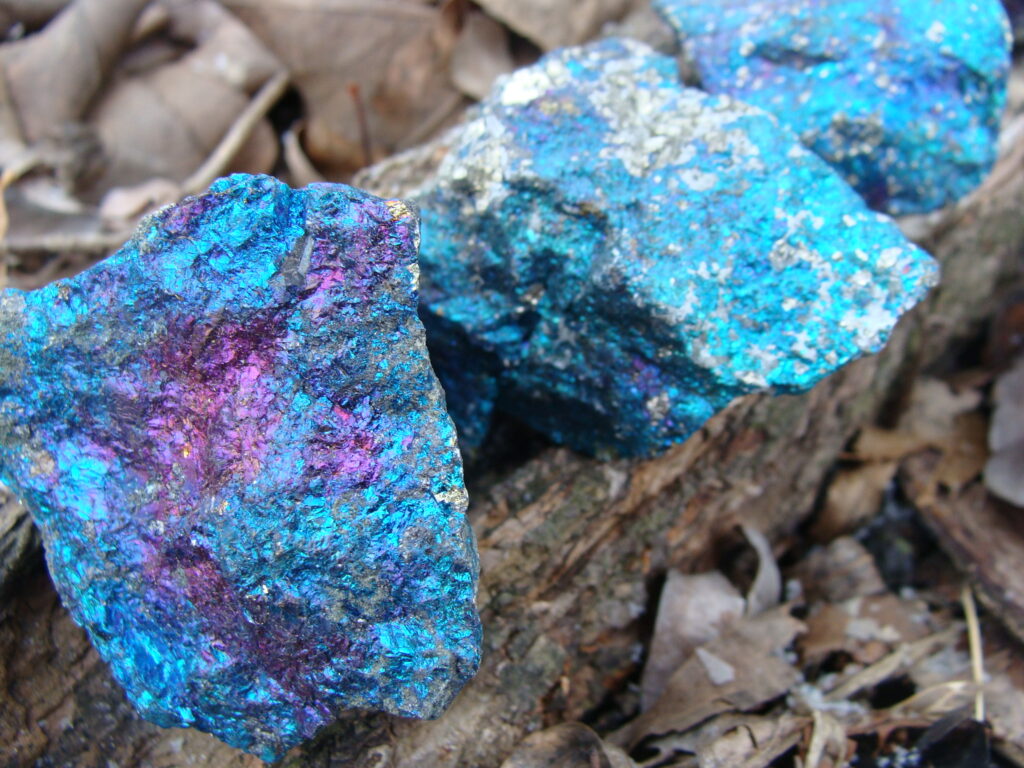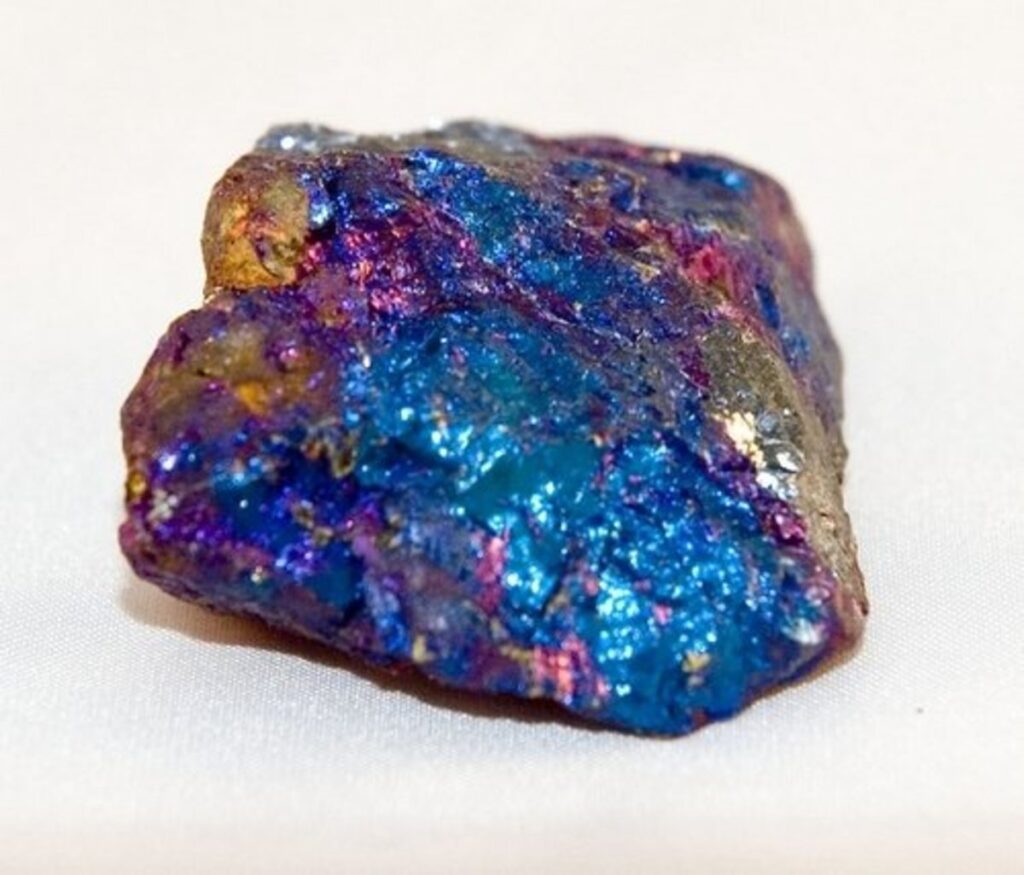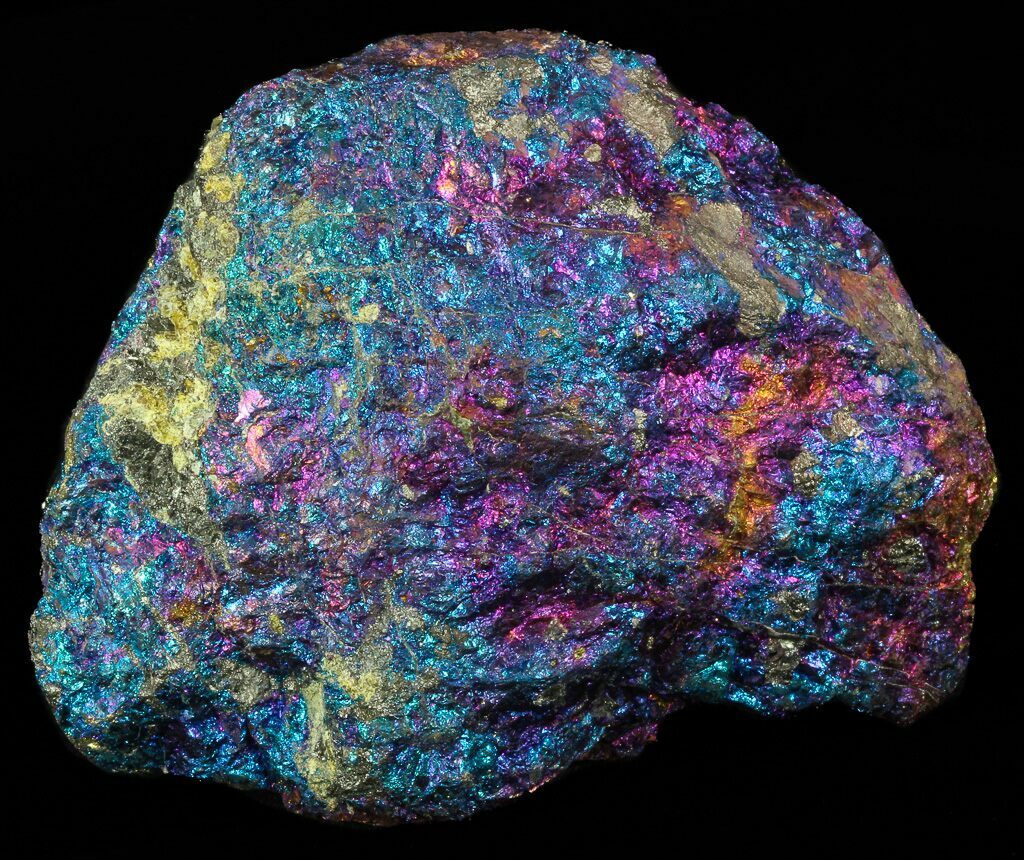Peacock ore, also known as bornite, is a copper-iron sulfide mineral famed for its striking iridescent hues, which appear in shades of purple, blue, green, and yellow. Its colors resemble the vibrant plumage of a peacock, giving rise to its nickname. While the mineral is often appreciated for its aesthetic appeal and use in jewelry, it also holds significant geological and economic importance as an ore of copper. This article delves into the mineral’s geological formation, properties, and uses, offering a comprehensive overview of peacock ore’s role in the geologic world.

Geological Composition and Characteristics of Peacock Ore
Peacock ore, with the chemical formula Cu₅FeS₄, is primarily composed of copper and iron sulfides. Classified as a sulfide mineral, it is part of the mineral group containing metal and sulfur compounds, many of which are critical ores for metal extraction. Bornite typically contains around 63% copper, making it a valuable copper ore that serves as a major source of copper in various mining regions.

- Crystal Structure and Formation:
Bornite belongs to the isometric crystal system, forming in irregular masses rather than distinct crystals. It has an orthorhombic structure at high temperatures and transforms into a cubic structure as it cools. This transformation, along with its high copper content, makes bornite more common in hydrothermal and porphyry copper deposits, often found alongside other copper sulfide minerals like chalcopyrite and chalcocite. - Physical Properties:
- Color: Freshly mined bornite has a metallic brown to copper-red appearance but quickly tarnishes, acquiring the famous iridescent colors.
- Hardness: Bornite ranks between 3 and 3.25 on the Mohs hardness scale, making it relatively soft.
- Streak: The streak of bornite is grayish black, which can help distinguish it from similar minerals in hand specimens.
- Specific Gravity: With a specific gravity of around 5 to 5.1, bornite is denser than many other minerals, aiding in its identification during mineral exploration.
The Geologic Formation of Bornite

Peacock ore forms predominantly in hydrothermal environments, where mineral-rich, high-temperature fluids deposit metal sulfides within cracks and fissures in the earth’s crust. It typically originates from primary igneous processes but can also form through secondary supergene enrichment, where oxidation of primary copper minerals leads to the creation of new secondary minerals at shallower depths.
- Hydrothermal Vein Deposits:
Bornite frequently occurs in hydrothermal veins, which form when hot, mineral-laden fluids rise from deep within the earth. These fluids can deposit copper, iron, and sulfur, leading to the crystallization of minerals like bornite. Often, hydrothermal veins containing bornite are associated with other copper minerals like chalcopyrite and pyrite, as well as with silver and gold in some cases. - Porphyry Copper Deposits:
Peacock ore is also found in porphyry copper deposits, one of the most significant sources of copper globally. These deposits form in association with large intrusions of igneous rock. Bornite within these deposits occurs in disseminated form, meaning it is spread out in small particles rather than concentrated in veins, which makes it more challenging to extract but valuable due to the sheer volume of copper present. - Supergene Enrichment Zones:
In weathered parts of the earth’s crust, bornite can form through supergene processes, where primary copper sulfide minerals (like chalcopyrite) undergo chemical alteration and enrich the copper content in the upper layers of an ore deposit. In these zones, bornite may occur alongside secondary minerals like chalcocite, which also contain high concentrations of copper.
Geological Occurrence and Mining Locations

Bornite deposits are found across the globe, particularly in areas known for copper production. Major deposits include those in the United States (Arizona and Montana), Chile, Peru, Mexico, Canada, and parts of Australia. In the U.S., Arizona’s Morenci and Bisbee mining districts are particularly well-known for their rich bornite and chalcopyrite deposits, which contribute to the country’s copper output.
- Montana, USA:
The Butte mining district in Montana is one of the most famous localities for bornite, where it has been mined along with other copper-rich minerals for over a century. - Chile:
Chile hosts some of the largest porphyry copper deposits in the world, notably the Chuquicamata mine, which yields significant amounts of copper sulfides like bornite. The mine’s deposits are deep-seated, requiring extensive infrastructure for extraction. - Mexico and Peru:
Known for high-grade deposits, Mexico and Peru are major copper producers with deposits that contain high-quality bornite as well as other copper sulfides. The mountainous geology and volcanic origins of these regions have contributed to the formation of copper-rich hydrothermal systems.
Economic Importance and Uses

As an important copper ore, bornite has substantial economic value. Copper extracted from bornite is essential for industries requiring high-conductivity materials, including electronics, construction, transportation, and renewable energy. The value of bornite and other copper minerals has grown alongside the demand for copper in developing sustainable technologies like electric vehicles and solar power.
In addition to its economic value, bornite is sought after by mineral collectors and jewelers for its vivid colors. However, the tarnish layer that gives bornite its iridescent appearance is a secondary alteration; bornite must be kept dry and protected from abrasion to maintain its vibrant coloration, as moisture and exposure can dull its surface.
Peacock Ore vs. Chalcopyrite: Common Confusion in Identification
Peacock ore is often confused with chalcopyrite (CuFeS₂), another copper-iron sulfide with similar iridescent qualities. However, chalcopyrite has a lower copper content (about 35%) and forms a tetragonal crystal structure, as opposed to bornite’s isometric structure. Chalcopyrite has a brassy yellow color, often tarnishing to greenish or purplish shades, which adds to the confusion. Geologists distinguish the two by testing for hardness (chalcopyrite is slightly harder) and using chemical assays to confirm copper content.
Environmental and Geochemical Implications

Bornite formation and mining have significant environmental implications. Copper extraction requires energy-intensive processes that produce tailings and waste material, often leading to land degradation and water pollution if not managed properly. The tailings from copper mines may contain sulfur, which can generate sulfuric acid upon exposure to air and water, leading to acid mine drainage—a major environmental concern for mining operations globally.
Summary
Peacock ore, or bornite, is a fascinating mineral that combines geological significance with aesthetic appeal. Its formation in hydrothermal veins and porphyry copper deposits highlights the intricate geological processes that concentrate copper, iron, and sulfur in specific locations, shaping the economic landscape and meeting global demands for copper. While bornite’s iridescent tarnish makes it popular among collectors, its true value lies in its role as a major copper ore, with a far-reaching impact on technology and industry.




































